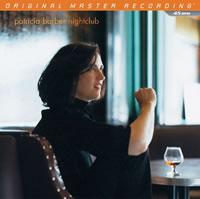Barber's Nightclub at 45rpm Takes You There
For some reason, audio enthusiasts have a need to latch onto female vocalists with a passion that borders on the fanatical. Once they find her, they never let go. The careers of Amanda McBroom, Jennifer Warnes, Diana Krall and Janis Ian have all benefited from this compulsive/obsessive behavior. I have nothing against it. I just find it fascinating.
The latest feminine object of audiophile affection is clearly Patricia Barber. The reasons are clear, among them being: piano-driven acoustic music, a distinctive, smoky-sounding voice and Jim Anderson’s brilliant recordings—analog or digital.
I’ve seen Barber live twice now, and she is a genuinely gifted performer, with a world-wide fan base that from what I could see at these concerts could hardly be called “low brow.” Yet there is an evident “backlash” against her that also border on “compulsive/obsessiveness.”
There’s the charge that she’s “not jazz.” In fact, an early New York Times review had her listed as “pop” (and Barber answered that with a wry song called “If This Isn’t Jazz” (found on her Companion album. I find the “not jazz” charge ludicrous. Is she not a jazz musician because she’s popular and her records sell reasonably well? Does being popular make you “pop?” The same “purists” who whine about jazz not being appreciated and who complain that these great artists don’t get the acclaim they deserve, are the first ones to turn on the ones who manage a modicum of success. I don’t get it.
That said, Barber’s music is not for everyone and no, she’s not in the same league as the late Shirley Horn, but then few contemporary female jazz vocalists are, and what does that have to do with appreciating Barber? Nothing. Yet I have heard a few folks whine about the Barber-fetish among audiophiles, while Horn remains below the musical horizon. Again, that’s too bad and not fair to either of these great ladies. End of rant.
Though this album is called Nightclub it is not recorded in one. Rather it is a carefully conceived studio album that attempts to create the feel of a nightclub after hours: intimate, one-on-one and very personal. So mostly this is a trio album, with Barber on piano backed by bassists Michael Arnopol or Marc Johnson, and drummers Adam Nussbaum or Adam Cruz. On three tracks Charlie Hunter adds 8-stringed guitar.
An album of standards—shopworn tunes that have all been covered through the years by others with longer and more glowing resumes—was clearly a risky proposition inviting comparison. Yet Barber inhabits the tunes, lives in them and discovers ways to freshly deliver them. That’s what an original stylist can do, and Barber is clearly one of those. She does it without frills or affectations. Instead, she holds back and ends up expressing more by doing less. That takes an inner strength coupled with vulnerability that Barber exudes—especially if you do get to see her live.
Anyone who can bring something new to “Bye Bye Blackbird,” “Autumn Leaves,” and even “(What’s It All About) Alfie” gets a tip of the stylus from me.
Other tunes include Eddy Arnold’s “You Don’t Know Me,” famously covered by Ray Charles, “Summer Samba,” which you know even if you don’t think you do, and “A Man & A Woman.” Even Barber’s sambas and bossa novas have a deliberate pacing and a weighty mysterious air, with little of the expected sunny lilt, yet they don’t fall down.
This is a performance from all that draws you in, rather than pushing you back in your listening chair. All of the performances are of a singular, sultry mood that is both Barber’s biggest draw and her biggest weakness, as she doesn’t seem capable of breaking free of it to express some other range of colors. But that’s an issue for another day or for another record because this one sets a mood that’s deep and warm, like a comfortable chair you’re in no hurry to exit. The spaces between the notes are as nourishing and palpable as what she chooses to express physically.
The warm, inviting recording gives the illusion of being simplicity itself, with Barber, piano and bass center stage and the drum kit spread subtly across it. Even Barber’s keyboard extends outward from the center as she plays. The images are larger than life and vibrant. The glue that holds the picture together and gives the images body and dimensionality is the rich, natural ambience Anderson skilly adds to these live performances (only one featured a backing track over which Barber later added vocals) thanks to a live chamber set up in a hallway and adjacent landing, using speakers and microphones.
24 channels (give or take a few) of digitally recorded sound (a Sony 3348 48 channel machine) mixed to 2 track ½” Dolby SR encoded analog tape produced the rich, inviting sound you’ll hear on this double LP 45rpm set or on the SACD release.
This is the third Mo-Fi double 180 gram LP Barber box set I’ve auditioned, and according to Music Direct, which owns Mobile Fidelity, as with the others, it is among the label’s best sellers despite the steep price. What’s more, the purchasers are the same folks who bought the others. Call them fans, or fanatics, they obviously know what they like. At least one of these great sounding sets belongs in your record collection. This is the one I’d save for a rainy day.




